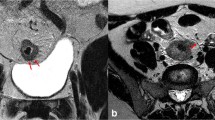Abstract
Purpose
The purpose of the study is to describe the CT findings of poorly differentiated (PD) colorectal adenocarcinoma (CRAC) compared with those of well- (WD) or moderately differentiated (MD) CRAC.
Materials and methods
One hundred and thirteen patients with pathologically proven PD (n = 26), WD (n = 35), or MD (n = 52) CRACs and who had undergone preoperative, contrast-enhanced multidetector CT (MDCT) imaging were included. Analysis of the CT findings included the morphologic and enhancement features of primary tumors and regional lymph nodes (LNs), and the presence of direct invasion, colonic obstruction, and distant metastasis. The significance of these findings was determined using the χ 2 test.
Results
Significant features favoring the diagnosis of PD CRACs over WD or MD CRACs included their bulky shape, heterogeneous enhancement, iso- or hypoattenuation compared with that of muscle, nodular pericolic fat infiltration, regional LNs > 10 mm, and/or with iso- or hypoattenuation compared with that of muscle, and the presence of distant metastasis (P < 0.05). When at least two of these seven imaging features were used in combination, the sensitivity and specificity in the diagnosis of PD CRACs were 88% and 70%, respectively.
Conclusion
Using characteristic CT features, one can differentiate PD CRAC from WD or MD CRAC with a high degree of accuracy on contrast-enhanced MDCT.






Similar content being viewed by others
References
Siegel R, Naishadham D, Jemal A (2013) Cancer statistics, 2013. CA Cancer J Clin 63:11–30
Horton KM, Abrams RA, Fishman EK (2000) Spiral CT of colon cancer: imaging features and role in management. Radiographics 20:419–430
Kaur H, Choi H, You YN, et al. (2012) MR imaging for preoperative evaluation of primary rectal cancer: practical considerations. Radiographics 32:389–409
Takeuchi K, Kuwano H, Tsuzuki Y, et al. (2004) Linicopathological characteristics of poorly differentiated adenocarcinoma of the colon and rectum. Hepatogastroenterology 51:1698–1702
Kazama Y, Watanabe T, Kanazawa T, et al. (2008) Poorly differentiated colorectal adenocarcinomas show higher rates of microsatellite instability and promoter methylation of p16 and hMLH1: a study matched for T classification and tumor location. J Surg Oncol 97:278–283
Chung CK, Zaino RJ, Stryker JA (1982) Colorectal carcinoma: evaluation of histologic grade and factors influencing prognosis. J Surg Oncol 21:143–148
Jass JR (1988) The pathological grading and staging of rectal cancer. Scand J Gastroenterol Suppl 149:21–38
Mehrkhani F, Nasiri S, Donboli K, Meysamie A, Hedayat A (2009) Prognostic factors in survival of colorectal cancer patients after surgery. Colorectal Dis 11:157–161
Cho YB, Chun HK, Yun HR, et al. (2009) Histological grade predicts survival time associated with recurrence after resection for colorectal cancer. Hepatogastroenterology 56:1335–1340
Rosai J, Ackerman LV (2011) Gastrointestinal tract—large bowel. In: Rosai J (ed) Rosai and Ackerman’s Surgical Pathology, 10th edn. Amsterdam: Elsevier, pp 762–768
Sosna J, Morrin MM, Kruskal JB, et al. (2003) Colorectal neoplasms: role of intravenous contrast-enhanced CT colonography. Radiology 228:152–156
International Union Against Cancer (UICC) (2002) Histopathological grading. In: Sobin LH, Wittekind C (eds) TNM classification of malignant tumor, 6th edn. New York: Wiley-Liss, p 13
Hamilton SR, Vogelstein B, Kudo S (2000) Carcinoma of the colon and rectum. In: Hamilton S, Aaltonen L (eds) World health organization classification of tumors-pathology and genetics of tumors of the digestive system. Lyon: IARC Press, pp 105–119
Edge SB, Byrd DR, Compton CC, et al. (2010) Colon and rectum. In: Edge SB (ed) AJCC cancer staging manual, 7th edn. New York: Springer, pp 143–156
George SM, Makinen MJ, Jernvall P, et al. (2000) Classification of advanced colorectal carcinomas by tumor edge morphology: evidence for different pathogenesis and significance of polypoid and nonpolypoid tumors. Cancer 89:1901–1909
Cooper HS, Slemmer JR (1991) Surgical pathology of carcinoma of the colon and rectum. Semin Oncol 18:367–380
Dukes CE, Bussey HJ (1958) The spread of rectal cancer and its effect on prognosis. Br J Cancer 12:309–320
Biffi R, Botteri E, Bertani E, et al. (2013) Factors predicting worse prognosis in patients affected by pT3 N0 colon cancer: long-term results of a monocentric series of 137 radically resected patients in a 5-year period. Int J Colorectal Dis 28:207–215
Weiser MR, Posner MC, Saltz LB (2013) Adenocarcinoma of the colon and rectum. In: Yeo CJ, Pemberton JH (eds) Shackelford’s surgery of the alimentary tract, 7th edn. Philadelphia: Elsevier Saunders, p 2066
Foxtrot Collaborative Group (2012) Feasibility of preoperative chemotherapy for locally advanced, operable colon cancer: the pilot phase of a randomised controlled trial. Lancet Oncol 13:1152–1160
Nørgaard A, Dam C, Jakobsen A, et al. (2014) Selection of colon cancer patients for neoadjuvant chemotherapy by preoperative CT scan. Scand J Gastroenterol 49:202–208
Masuda H, Abe Y, Takayama T (2005) Microsatellite instability in poorly differentiated colorectal adenocarcinoma, particularly in relation to two subtypes. Hepatogastroenterology 52:82–85
De Sousa E, Melo F, Vermeulen L, Fessler E, Medema JP (2013) Cancer heterogeneity—a multifaceted view. EMBO Rep 14:686–695
Furukawa H, Hara T, Taniguchi T (1992) Colorectal carcinoma evaluated by incremental dynamic CT: comparison of CT density, histology, and tumor size. Gastroenterol Jpn 27:334–340
Kim JW, Jeong YY, Chang NK, et al. (2012) Perfusion CT in colorectal cancer: comparison of perfusion parameters with tumor grade and microvessel density. Korean J Radiol 13(Suppl 1):S89
Acknowledgments
Contract grant sponsor: This study was supported by grant no. 0420120500 from the SNUH Research Fund. Contract grant number: A100048.
Conflict of interest
None declared.
Author information
Authors and Affiliations
Corresponding author
Rights and permissions
About this article
Cite this article
Kim, J.E., Lee, J.M., Baek, J.H. et al. Differentiation of poorly differentiated colorectal adenocarcinomas from well- or moderately differentiated colorectal adenocarcinomas at contrast-enhanced multidetector CT. Abdom Imaging 40, 1–10 (2015). https://doi.org/10.1007/s00261-014-0176-z
Published:
Issue Date:
DOI: https://doi.org/10.1007/s00261-014-0176-z




